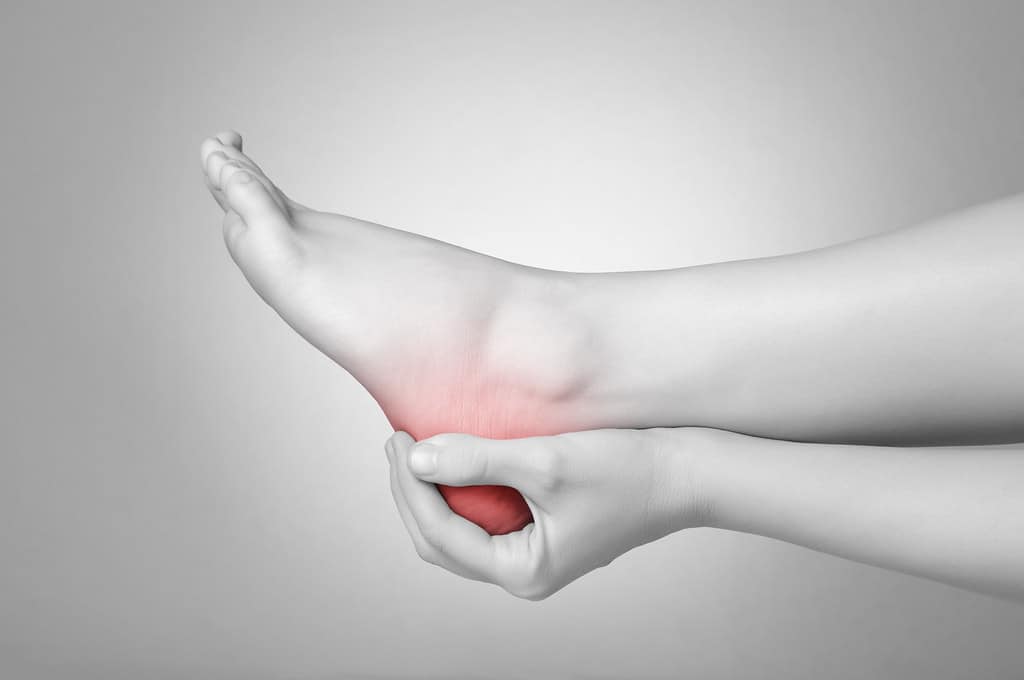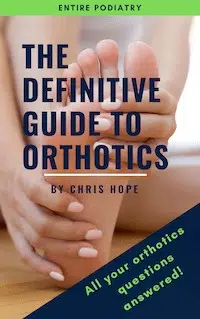Other causes of heel and arch pain
Whilst plantar fasciitis is the most common cause of heel and arch pain, it is not the only cause. Other causes include:
- Plantar fascia tear
- Muscle tear/strain
- Bruising of the fat pad
- Tarsal tunnel syndrome
- Nerve entrapment
- Calcaneal stress fracture
- Soft tissue mass
- Gout
- Systemic arthritis
This is why it is important to make an appointment to see your podiatrist so they can thoroughly assess your foot pain to ensure you have the correct diagnosis. Incorrect treatment based on an incorrect diagnosis may cause the problem to worsen.

Plantar fasciitis and your pain
Not everyone with plantar fasciitis will present with the exact same symptoms and pain. The location of your pain will depend on which part of the plantar fascia is injured. Often, pain occurs in more than one of these locations, or even in different locations on each foot.
Plantar fasciitis and arch pain
Pain in the arch is one of the more common locations of pain for plantar fasciitis. Pain in the arch occurs when the ligament itself is strained and overused. The pain can occur anywhere along the arch from the base of the heel towards the toes.
Plantar fasciitis and heel pain
Pain at the base of the heel is another very common location. Pain in the heel occurs where the plantar fascia inserts onto the base of the heel bone. The ligament pulls on the heel bone creating traction and causing inflammation and pain. This pain can feel like a ‘stone bruise’ and can be very painful when any pressure is applied to the heel.
Plantar fasciitis and pain under toes
Plantar fasciitis can also cause pain under the toes. Pain under the toes occurs when the plantar fascia is strained and overused where it inserts near the toes. Pain in this location is more common in those with a high arched foot.
Plantar fasciitis and Achilles tendonitis
Whilst plantar fasciitis and Achilles tendonitis are two different conditions they share some similarities and can be closely related. It is not uncommon to have these two conditions occur concurrently.
Tightness in the calves causes restricted ankle movement and this can lead to both plantar fasciitis and Achilles tendonitis.
Many of the other ‘risk factors’ for plantar fasciitis e.g. inappropriate footwear, excessive load through your feet, and poor biomechanics, can also lead to problems with your Achilles tendon.
With painful Achilles tendonitis you may begin to walk differently, even without meaning to, in order to avoid stretching the painful Achilles. This ‘compensation’, or change in walking style, can place excessive strain through the plantar fascia. This can also occur the other way around; where the pain from plantar fasciitis may change the way you walk, you may perhaps avoid placing your heel on the ground, which can put too much strain through the Achilles tendon.
As part of your biomechanical assessment, your podiatrist will conduct a thorough assessment of your lower limb function and walking style and will identify if you may also be at risk of overloading your Achilles tendon.
Plantar fasciitis causing knee and hip pain
With painful plantar fasciitis you may begin to walk differently, even without meaning to, in order to avoid putting weight on your foot. This compensation, or change in walking style, can place excessive strain through your hips and knees as you favour one side. The first step in treating this is to address the plantar fasciitis pain in order to encourage a more ‘normal’ walking style, which may help with the knee and hip pain.
Plantar fasciitis and back pain
With painful plantar fasciitis you may begin to walk differently, even without meaning to, in order to avoid stretching and putting weight on your foot. This compensation, or change in walking style, can place excessive strain through your back as you favour one side or ‘protect’ your sore foot. The first step in treating this is to address the plantar fasciitis pain in order to encourage a more ‘normal’ walking style, which may help with the back pain.
Plantar fasciitis and shin splints
Whilst plantar fasciitis and shin splints are two different conditions they share some similarities and can be closely related. It is not uncommon to have these two conditions occur concurrently.
There are two different types of shin splints, anterior and posterior shin splints. Posterior shin splints are more commonly related to plantar fasciitis. Posterior shin splints are also referred to as Medial Tibial Stress Syndrome (MTSS).
A risk factor for both plantar fasciitis and MTSS is over-pronation (too much rolling in of the foot). This can be caused by weakness of a muscle called your tibialis posterior. One of the important actions of the tibialis posterior muscle is to stabilise and support the arch of the foot and the inner ankle. When this muscle is weakened it can cause the arch to collapse and the foot to roll in i.e. over-pronation. This over-pronation causes the plantar fascia to be stretched and overused and can also create shinbone stresses i.e. shin splints.
As part of your biomechanical assessment, your podiatrist will conduct a thorough assessment of your lower limbs and walking style and will identify if you may also be at risk of overloading your calf muscles and shins. If you are they will design some exercises to help prevent and manage this.
Many of the other ‘risk factors’ for plantar fasciitis including inappropriate footwear, excessive load through your feet, increasing your training load too quickly and poor biomechanics, can also lead to problems with your shins.
Plantar fasciitis and heel spurs
‘Plantar fasciitis’ and ‘heel spurs’ are often confused and used to describe the same condition. Whilst both of these conditions are similar, they are not the same. Heel pain may be associated with a heel spur, however the pain itself is usually due to plantar fasciitis; e.g. a painful ligament, rather than the bony spur itself. Therefore treatment is directed towards healing the plantar fascia ligament, which in turn reduces the strain of the ligament from the spur.
Plantar fasciitis causing extreme pain
The pain from plantar fasciitis can vary in intensity from a mild annoyance in the mornings or after exercise to absolutely debilitating. We see patients who are in so much pain they are unable to walk. Pain this severe affects many aspects of their life, from the ability to work, to exercise, to even being able to drive. Patients suffering from extreme plantar fasciitis can be in so much pain they find it hard to get out of the house to enjoy their weekends.
Even chronic (long-standing) and very painful plantar fasciitis can be treated with the correct treatment plan. Your podiatrist will always take into account the duration of your pain and its severity when designing a treatment plan for you. It is important to note that chronic plantar fasciitis can take a long time to resolve, up to 12 months for severe and long-standing cases.
If not treated plantar fasciitis tends to get worse. As with most overuse injuries, it is easier to successfully treat plantar fasciitis in the early stages of the condition. As the condition goes untreated the disease progresses from an acute to a chronic nature. Chronic plantar fasciitis is more stubborn and slow to heal as more damage has been done and there is more to repair. This is why we always recommend seeking help from our podiatrists as soon as you notice pain for an easier and quicker recovery. However, it is never too late to begin treatment.
Separate links for more info on treatments
Plantar Fasciitis and Footwear
Footwear plays a vital role in supporting and cushioning out feet. Therefore its no surprise that incorrect footwear is one of the leading causes of plantar fasciitis. Your podiatrist will work with you to discuss what shoes are appropriate for you and your ‘foot type’, whilst paying attention to your preferences and personal requirements. We recommend you bring your shoes to your consult so the podiatrist can assess them.
Podiatrist recommended footwear for plantar fasciitis
We understand the importance of working with you, especially when it comes to shoes. This is why we won’t tell you to wear one specific type of shoe. A common complaint from patients is that they are ‘told’ by podiatrists to wear shoes that don’t work for them or fit in with their work requirements or personal preferences. At Entire Podiatry we will advise the best types of shoes for you but also listen to you and work with your needs and preferences, after all, there is no point is owning a pair of the ‘perfect shoes’ if you are not going to wear them.
Most supportive shoes for plantar fasciitis
As with the rest of the treatment for plantar fasciitis, there is no single ‘best shoe’ for plantar fasciitis. The best shoe will depend on your foot type and your needs. The podiatrist will work with you to discuss the right features to look for in a shoe to improve your foot function and allow healing of the ligament.
Our shoes
At Entire Podiatry our footwear range includes a wide variety of high quality podiatrist-endorsed footwear, in many different sizes and widths. Whether you are looking for casual or dress shoes, slippers or sandals, we have supremely comfortable footwear options to meet your needs. Our podiatrists are able to professionally measure your feet to ensure the correct length, width, depth and style for you.
Best summer sandals for plantar fasciitis
Wearing a supportive shoe does not mean that you need to be in joggers all year round, especially in the warmer Queensland climate. At Entire Podiatry, we sell a range of sandals which have been carefully selected to ensure they provide adequate support and cushioning to your foot. Many of the sandals we sell have a unique removable footbed. This removable footbed allows them to be worn with your orthotics. This is the perfect option to ensure that you are able to get your customised support that you require in a shoe that is suitable for your needs.
Talk to our team about the best type of sandal for you and if your current orthotics can work with these.
At Entire Podiatry, we also offer arch support thongs. These are a fantastic option for patients with plantar fasciitis. Having arch support in a pair of slip-on thongs means that you don’t have to give up on convenience in order to get the support your foot needs. These are a great option to wear around the house and provide a fantastic alterative for times when closed-in shoes are not appropriate.
Walking shoes for plantar fasciitis
The average person walks over 2 million steps a year! This is why it’s so important that your walking shoes are the correct fit and the correct type of shoe for you. At Entire Podiatry, we offer a range of high quality podiatrist-endorsed walking shoes, in many different sizes and widths. Our podiatrists are able to professionally measure your feet to ensure the correct length, width and depth and style for you.
We recommend you bring your walking shoes in for an assessment so our podiatrists can advise if it is the best type of shoe for you.
Slippers for plantar fasciitis
Many people with plantar fasciitis feel worse pain when walking barefoot around the house. A common complaint is that the foot feels much better when wearing supportive shoes and orthotics but these can’t be worn around the clock. At Entire Podiatry we can assist you with finding a pair of slippers for winter or for wearing around the house. Incorrect slippers may not only worsen your plantar fasciitis, but can also be a risk for falls.
Plantar fasciitis and surgery
Surgery may be required for plantar fasciitis. This is only considered as a last-resort. You will need to have tried conservative treatment (e.g. orthotics, footwear, rest, exercises etc.) for at least 12 months before the doctor will consider you an eligible candidate for surgery. As with any surgery there is always a risk of complications and a risk that the surgery is not successful.
Plantar fasciitis surgery procedure
Surgery for plantar fasciitis is known as ‘Plantar fascia Release’ surgery. This surgery involves the surgeon making small incisions in the plantar fascia to release the tension and reduce the inflammation. If there are heel spurs present the surgeon may also remove these.
Plantar fasciitis surgery success rate
As with any surgery there is always a risk that the surgery will not be successful. The techniques are improving constantly, but currently the success rate is about 80%.
Plantar fasciitis surgery recovery time
After the surgery, you will be required to wear a cast or a moon boot to avoid placing any pressure through the foot for the next 2-3 weeks. Most patients are able to return to normal shoes and normal activities about 6 weeks after the procedure. It may take at least 3 months before any high-impact activity can be carried out. E.g. running.
Plantar fasciitis and cortisone injections
If you have not been able to cure your plantar fasciitis after trying the conservative treatments (e.g. orthotics, footwear, rest, exercises etc.) you may benefit from a corticosteroid injection. This injection uses a synthetic version of your body’s natural cortisone to relieve the inflammation and pain.
What is the procedure?
These steroid injections for plantar fasciitis are injected into the foot using a thin needle. The doctor often uses an ultrasound to look into the foot to ensure the compound is being deposited into the correct area. The injection itself can be painful, and the doctor will usually add a numbing agent to the cortisone shot itself, or numb the area prior to injecting you.
Is this a guaranteed fix?
It is important to note that this does not ‘fix’ your plantar fasciitis, rather it reduces the pain that you feel. This is a very important consideration because the injection will numb the pain and it is possible for you to forget all about your plantar fasciitis and over-use your foot causing even more damage!
That is why if you are considering a corticosteroid injection, this treatment must be done in conjunction with the other treatment options discussed (e.g. footwear, rest, orthotics, exercises etc.). This will allow the plantar fasciitis to actually heal, rather than just be numbed.
It is also important to note that some people receive no relief from the corticosteroid injection. And the effect does not last forever. The effect can last for up to three months. The doctor may repeat the injections again after the first round has worn off. However many doctors won’t do this as repeated corticosteroid injections can weaken the ligament and make it more prone to rupture.
What is the recovery time?
You will need to spend some time resting your feet for at least 2-3 days following the procedure. Some people say that the pain actually gets worse before it gets better. After the third day, you should feel significant pain relief for about 3 months.
What is the cost?
You can expect to pay anywhere from $100 to $300 for cortisone injections depending on how many, your healthcare provider and insurance coverage.
Other questions regarding treatment
Can I heal my plantar fasciitis without surgery?
Yes! At Entire Podiatry we are able to treat the vast majority of plantar fasciitis cases with conservative treatment only.
It is quite rare for surgery to be required, especially if you are able to begin treatment soon after the initial pain.
It is important to note that plantar fasciitis can take a long time to resolve completely. There are cases which have taken up to 12 months to heal!
After a month of beginning treatment with Entire Podiatry you should be noticing a reduction in your symptoms. The more of the podiatrist’s recommendations you are able to adhere to, the quicker the resolution should be. It is also important to note that there are often ‘good days’ and ‘bad days’ in regards to your plantar fasciitis progression. Often the pain might spike up again for the few days following a long day on your feet or after wearing non-ideal shoes. But with patience and the correct treatment, the overall trend should be towards less pain each week.
It is important to meet up regularly with your podiatrist to make sure that you are progressing in the right direction. The treatment plan may need to be modified along the ways as your symptoms change and improve.
How can I relieve the pain of acute plantar fasciitis?
The general principles of RICE – Rest, Ice, Compression and Elevation are very useful in reducing the pain of acute plantar fasciitis. Also anti-inflammatory medication e.g. a topical gel or ibuprofen tablets can also assist with the pain. It is essential that you speak to your GP first to make sure these medications are right for you.
What happens if I don’t treat my plantar fasciitis?
Generally, the earlier you are able to begin treatment your plantar fasciitis the easier it is to recover from.
Symptoms often begin as mild and occur either first thing in the morning or after exercise. If left untreated the pain increases in severity and can remain all day, even when you aren’t on your feet. When this has occurred it is likely that your plantar fasciitis has become ‘chronic’ in nature. Chronic plantar fasciitis is more difficult to treat as there is more damage to the ligament and the surrounding tissues.
Whilst not impossible, it is very rare for plantar fasciitis to go away by itself with no treatment.
I’ve had plantar fasciitis in the past, what’s the best way to care for my feet to ensure it does not return?
After winning the battle against plantar fasciitis its safe to say that the last thing you want is for this condition to return again. However, unfortunately, recurring plantar fasciitis is very common. Especially if what caused the plantar fasciitis in the first place is not adequately addressed. For example you should continue to avoid the footwear that caused the initial pain, address the biomechanical flaws e.g. flat feet, muscle tightness and continue to pay attention to your training loads.
The treatment advice that has been given to you by your podiatrist is not only useful in the treatment of plantar fasciitis but also to prevent its recurrence. After your symptoms have ceased, it’s important to talk to your podiatrist to find out how long you should continue your treatment plan.
Do you offer shockwave therapy for plantar fasciitis?
Shockwave therapy can be used in the treatment of plantar fasciitis. Shockwave delivers acoustic shock waves that penetrate the skin and stimulate tissue repair mechanisms. It is thought to stimulate healing through the creation of blood vessels which repair the musculoskeletal tissues.
Shockwave therapy is prescribed in combination with other treatments such as exercises and stretches, footwear advice and orthotics.
Currently at Entire Podiatry we do not offer shockwave treatment but we do keep up-to-date with this type of treatment for plantar fasciitis. In general when patients have shockwave treatment we see approximately one third of patients have great results, one third have some improvement and one third see no improvement.
At Entire Podiatry we have so much success treating plantar fasciitis with other methods, such as orthotics, strapping, footwear and exercises that we often do not need to refer patients for shockwave treatment.
I am pregnant, does treatment change for me?
Plantar fasciitis often occurs during or following pregnancy. The sudden increased body weight caused by pregnancy places more force and load through the feet. This can cause the plantar fascia to carry more force than it can handle.
The hormonal changes that occur during pregnancy cause the ligaments across the whole body to change and loosen. This also has an effect on the plantar fascia, causing it to loosen and flatten out and causing pain.
This looseness in the ligaments felt with pregnancy can also affect the ligaments around the knee. Pregnant or new mums often note an increased feeling of ‘weakness’ or ‘instability’ around the knees or the ankles.




